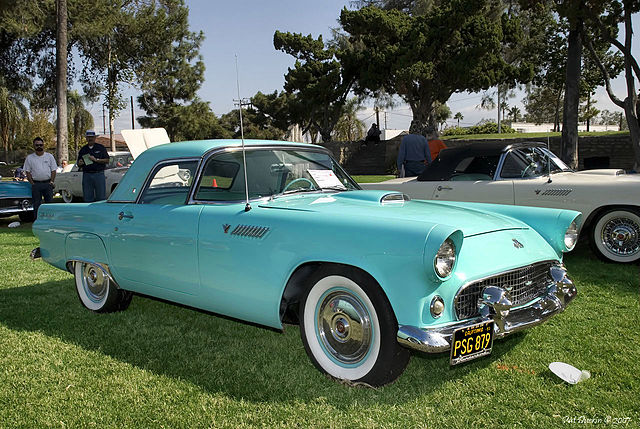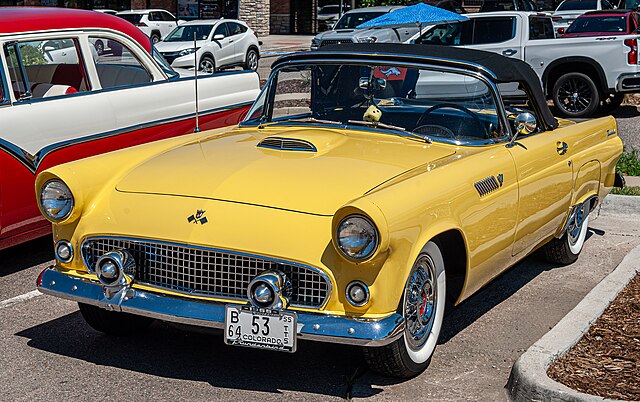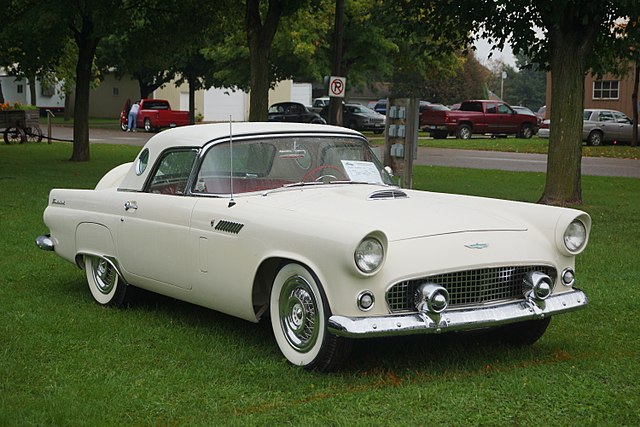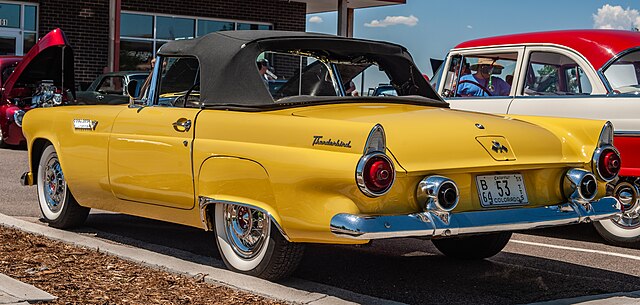
The Ford Thunderbird, launched in the mid-1950s, carved a unique niche in automotive history, blending luxury with performance in a way that captured the imagination of the American public. Its introduction marked the birth of the personal luxury car segment, offering a unique combination of style, comfort, and performance that was unmatched at the time.
This article delves into the first generation of the Thunderbird, exploring its origins, design, performance, cultural impact, and legacy.
Origins and Development

The Ford Thunderbird’s inception was a direct response to Chevrolet’s Corvette, but with a twist. Ford aimed to create not just a sports car but a “personal luxury car,” a concept that was novel at the time.
The Thunderbird project, code-named “E-Bird,” was initiated in 1953, and the car was ready for its market debut just a few years later, in 1955. Unlike the Corvette, which prioritized speed, the Thunderbird focused on comfort and driving pleasure, appealing to a broader segment of buyers.
The design team, led by Frank Hershey, sought to merge European design sensibilities with American innovation. The result was a vehicle that boasted a sleek and stylish exterior, complete with tailfins that would become iconic. The interior was equally impressive, designed with luxury in mind, featuring high-quality materials and the latest technology of the time.
Ford’s gamble paid off, and the Thunderbird’s unveiling was met with critical acclaim. The public’s response was overwhelmingly positive, with the car’s luxurious features and distinctive design setting it apart from its competitors.
Design and Features

The first-generation Thunderbird’s design was revolutionary, featuring a two-seat configuration that combined sportiness with luxury. Its aesthetic was a blend of modern and classic cues, featuring a long hood, short rear deck, and subtle tailfins that gave it a dynamic, forward-moving appearance.
The car’s design was not just about looks; it also incorporated functional elements like the removable fiberglass hardtop, which allowed drivers to enjoy an open-air experience while providing the option for all-weather protection.
The interior of the Thunderbird was where luxury truly came to the forefront. It was equipped with features that were considered advanced for the era, such as power seats, windows, and a sophisticated dashboard that included a tachometer and clock. The emphasis on comfort and convenience was clear, setting a new standard for what drivers could expect from a personal car.
Color played a significant role in the Thunderbird’s allure, with Ford offering a wide palette of exterior colors and interior trims. This customization allowed buyers to personalize their Thunderbirds, making each car distinct and reflective of its owner’s tastes.
Performance and Engineering

Under the hood, the Thunderbird was no slouch. The first models were equipped with a 292 cubic inch (4.8 L) Y-block V8 engine, capable of producing 193 horsepower. This engine was paired with a three-speed manual transmission with an optional overdrive, or a Ford-O-Matic automatic transmission, giving drivers a balance of power and ease of use.
In 1956, Ford introduced a more powerful 312 cubic inch (5.1 L) V8 engine as an option, increasing the output to 215 horsepower with the standard configuration and up to 225 horsepower with the “E-code” version, featuring dual four-barrel carburetors. This enhancement solidified the Thunderbird’s reputation as a capable performer on the road.
The Thunderbird’s suspension and chassis were also noteworthy. Ford implemented a unique combination of features to ensure the car delivered not just on straight-line speed but also provided a comfortable and controlled driving experience. This attention to the driving dynamics helped differentiate the Thunderbird from its competitors, making it a favorite among those who valued both performance and luxury.
Cultural Impact

The Ford Thunderbird quickly became more than just a car; it was a cultural icon. Its appearances in movies, television shows, and other media cemented its status as a symbol of style and sophistication. Celebrities and public figures were often seen driving Thunderbirds, further elevating its image.
The Thunderbird also had a significant impact on automotive design, influencing the development of personal luxury cars in the decades that followed. Its success prompted other manufacturers to explore this new segment, leading to the emergence of similar models that sought to replicate the Thunderbird’s blend of performance and luxury.
Beyond its immediate market impact, the Thunderbird became a beloved classic, admired by car enthusiasts and collectors around the world. Its legacy is celebrated at car shows, in clubs dedicated to preserving and enjoying classic Thunderbirds, and in the continued admiration it receives from fans of automotive history.
Legacy and Influence

The first-generation Ford Thunderbird set a precedent that would define the personal luxury car segment for years to come. Its blend of elegant design, innovative features, and engaging performance proved to be a winning formula. The Thunderbird underwent numerous evolutions over the years, but the first generation remains one of the most beloved and iconic models.
Today, the Thunderbird is revered not just as a classic car but as apiece of American cultural history. Its influence can be seen in the design cues and luxury features of many modern cars. The concept of a vehicle that combines the thrill of driving with the comfort and amenities of a luxury car continues to be a popular formula, thanks in large part to the trail blazed by the Thunderbird.
The preservation of first-generation Thunderbirds has become a passion for many enthusiasts, with restoration projects aiming to capture the original glory of these vehicles. Clubs and organizations dedicated to the Thunderbird provide a community for owners to share their experiences, knowledge, and love for this iconic car. These groups play a crucial role in keeping the legacy of the Thunderbird alive, organizing events and rallies that celebrate its history and impact.
The first-generation Thunderbird also serves as an educational piece in the history of automotive design and marketing. It stands as a testament to Ford’s innovation during the 1950s, showing how the company responded to market trends and consumer desires with a product that was both timely and timeless.
The Thunderbird’s success story is studied by automotive historians and business analysts alike, providing insights into the dynamics of the automotive industry and the strategies behind creating a brand that resonates with consumers.
In conclusion, the Ford Thunderbird 1st Generation (1955-1957) remains a landmark in automotive history. Over the years, the Thunderbird has evolved, but the essence of what made the first generation special continues to influence the automotive world. Its legacy is not just in the vehicles themselves but in the cultural impact they had, shaping perceptions of what a car could be and inspiring generations of designers, engineers, and drivers. As we look back on the Thunderbird’s journey, it’s clear that its wings have left an indelible mark on the landscape of American motoring.
